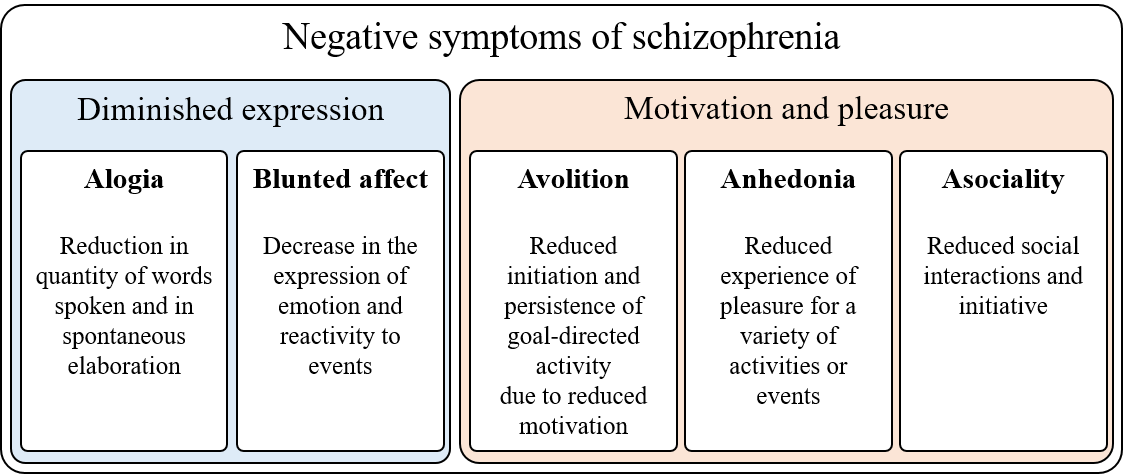-

Alexandre Seillier, Ph.D.
Working group leader
Schizophrenia is a chronic mental illness characterized by disturbances in mutliple modalities and with a heterogeneous combination of positive and negative symptoms as well as cognitive deficits. Although the positive symptoms (i.e., hallucinations, delusions, and thought disorders) are the most vivid and conspicuous, they are not necessarily the most important and characteristic ones. The negative symptoms, which refer to a diminution or absence of normal behaviors related to motivation and pleasure (i.e., avolition, anhedonia, and asociality) or expression (i.e., blunted affect and alogia), have indeed a much greater effect on the patient’s quality of life.

The current conceptualization of the negative symptoms
It is generally accepted that they are best modeled either as five discrete domains or as a hierarchical structure consisting of two overarching higher-order dimensions (i.e. ‘diminished expression’ and ‘motivation and pleasure’).
Their recognition as the hallmarks of the illness dates back to the earliest descriptions by the founding fathers of schizophrenia research. Specifically, in Kraepelin’s and Bleuler’s conceptualizations, disturbances in social/emotional function were considered the key feature of schizophrenia and referred to as ‘fundamental’ over the ‘accessory’ (i.e., positive) symptoms. In agreement with this early description, negative symptoms account for a large part of the long-term disability and poor functional outcomes in patients with schizophrenia, thus posing a substantial burden on them, their families, and health-care systems. Further, they are unaddressed by available antipsychotic drugs – the mainstay of treatment for schizophrenia – and drugs with innovative mechanisms of action are required. Despite considerable efforts over the past decades, no treatment has yet emerged to have clinically meaningful efficacy on primary negative symptoms – i.e., negative symptoms that are not secondary to positive symptoms, medication side effects, or other factors – and, to date, negative symptoms remain a critical unmet therapeutic need.
Owing to their significant contribution to functional impairment in schizophrenia, it is paramount to understand the pathophysiology of these debilitating symptoms, identify novel pharmacological targets, and translate this knowledge into new therapies. In this connection, the overarching research topic of the SMART Lab centers on understanding the neuropsychopharmacological underpinnings of the negative symptoms of schizophrenia. Specifically, we use animal models for schizophrenia together with behavioral, neuropsychological, and pharmacological methods, coupled with stereotaxic surgery, functional neuroanatomy, and molecular techniques, to identify the underlying neurobiological mechanisms, as well as the altered neuropsychological processes, underlying behavioral phenotypes reminiscent of the negative symptoms of schizophrenia. Ultimately, the goal is to identify novel pharmacological targets and translate this knowledge into new therapies for what has been referred to as the worst disease affecting mankind, namely schizophrenia.
Feel free to contact Dr. Seillier if you are interested in joining his lab as a student or postdoc. Motivated students at all levels are always welcome to inquire about positions.
-

Aditya Kumar, Ph.D.
Research and development worker